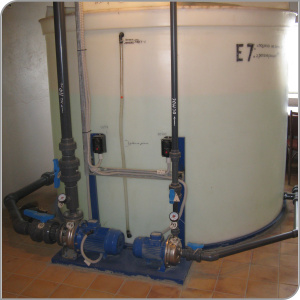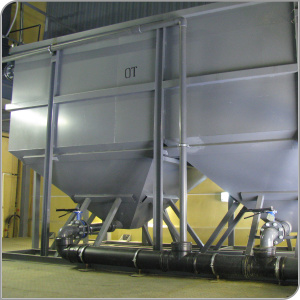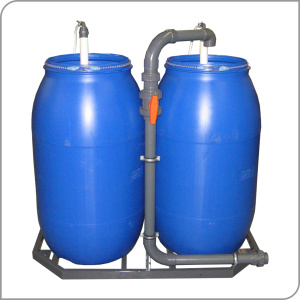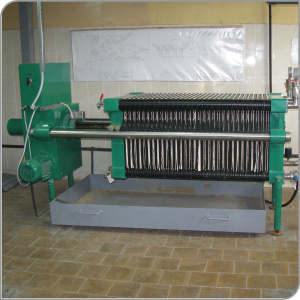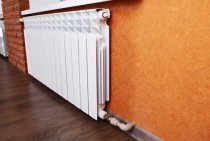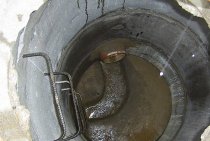Treatment of conditionally clean industrial effluents
Conditionally clean industrial effluents with mechanical impurities enter three mechanical settling tanks with a capacity of 148.5 m3 each, and the receiving well of which is supplied with milk of lime. Mechanical settling tanks are equipped with a waste oil collection unit (rotary pipe) which is collected in a settling tank with a volume of 140 m³. The accumulated sludge in the mechanical settling tanks of the treatment facilities is pumped out of the settling tanks and fed for dehydration to sludge pits measuring 40x48 m. Conditionally clean industrial effluents after settling and separating oil products are fed to a pumping pumping station and then to the city collector.
Table 11
The balance of water consumption and wastewater disposal of shop No. 20 of JSC "TOZ"
|
N p / p |
equipment identification |
Unit ism |
Qty |
Norm of water consumption |
Water consumption |
Water consumption |
Dead Losses |
||||||||
|
units |
Tot. |
Drinking water |
river water |
Well water |
msut |
year |
msut |
year |
|||||||
|
msut |
year |
msut |
year |
msut |
year |
||||||||||
|
1 |
2 |
3 |
4 |
5 |
6 |
7 |
8 |
9 |
10 |
11 |
12 |
13 |
14 |
15 |
16 |
|
1 |
Paint spray booth |
PC. |
5 |
0,5 |
2,5 |
154,8 |
38700 |
134,1 |
33516,9 |
20,7 |
5184,3 |
||||
|
2 |
hall bath. flushing Y=0.4 m3 |
PC. |
4 |
0,8 |
3,2 |
51,2 |
12851,2 |
38 |
9538 |
13,2 |
3313,2 |
||||
|
3 |
bath mountains. flushing Y=0.4 m3 |
PC. |
1 |
0,4 |
0,4 |
6,4 |
1606,4 |
3,08 |
773,08 |
3,32 |
833,32 |
||||
|
4 |
hall bath. flushing Y= 0.4 m3 |
PC. |
19 |
0,8 |
15.2 |
243,2 |
61043,2 |
157,04 |
39417,04 |
86,16 |
21626,16 |
||||
|
5 |
hall bath. flushing Y= 1.5 m3 |
PC. |
4 |
3 |
12 |
192 |
48192 |
136,4 |
34236.4 |
55,6 |
13955,6 |
||||
|
6 |
bath mountains. flushing Y= 0.4 m3 |
PC. |
19 |
0,4 |
7,6 |
121,6 |
30521,6 |
90,44 |
22700,44 |
31,16 |
7821,16 |
||||
|
7 |
bath mountains. flushing Y= 1m3 |
PC. |
4 |
1 |
4 |
64 |
16064 |
51,6 |
12951,6 |
12,4 |
3112,4 |
||||
|
8 |
degreasing bath. U = 0.4 m3 |
PC. |
12 |
0,4 |
4,8 |
0,24 |
60,24 |
0,24 |
60,24 |
||||||
|
9 |
degreasing bath. Y= 0.4 m |
PC. |
18 |
0,4 |
7,2 |
0,36 |
90,36 |
0,36 |
90,36 |
||||||
|
10 |
rinsing, bath hol. water U= 1m3 |
PC. |
13 |
2 |
26 |
416 |
104416 |
309,2 |
77609,2 |
106,8 |
26806,8 |
||||
|
11 |
rinsing, bath hol. water U = 0.4 m3 |
PC. |
15 |
0,8 |
12 |
192 |
48192 |
136,4 |
34236,4 |
55,6 |
13955,6 |
||||
|
12 |
rinsing, bath water U = 1 m3 |
PC. |
7 |
1 |
7 |
112 |
28112 |
81,8 |
20531,8 |
30,2 |
7580,2 |
||||
|
13 |
rinsing, bath hol. water U= 0.5 m3 |
PC. |
4 |
1 |
4 |
64 |
16064 |
45,6 |
11445,6 |
18,4 |
4618,4 |
||||
|
14 |
Total: |
986,4 |
247586,4 |
1143 |
286892,2 |
1607,21 |
403409,7 |
522,19 |
23098,02 |
Table 13
Characteristics of treatment facilities
|
issue number |
Cleaning number Construction |
Year of commissioning Cleaning facility |
Cleaning method |
Frequency of water discharge, h/day |
Installation of instrumentation in a wastewater treatment plant |
Design Power msut |
Efficiency of treatment facilities |
Composition of treatment facilities |
Quantity of formed sediment, t/year |
The amount of sludge removed |
Place of sludge removal |
|||
|
SW |
pollutant concentration |
|||||||||||||
|
At the entrance |
When exiting |
|||||||||||||
|
Before cleaning |
After cleaning |
|||||||||||||
|
Citywide release to the city collector |
1. Wastewater treatment plant |
1958 reconstruction in 1968 |
Physico-chemical |
from 7 to 23 h - acid-base is processed on the duct-chromo-containing. after treatment 1 time in 2 hours |
pH-200 |
pH-200 |
1860,2858,69 |
pHCuFeZnNiSulfatesSuspended solids |
7-94-1502,60,77-0,0274,9-0,50,075-0,050,68-0,39-40-120 |
8,5-90,090,20,05-0,0193,6-0,40,06-0,0130,67-0,35745,6-95,5120-300 |
Accumulator of acid-base, chromium-containing. drains, fur. sump - 4 units sludge separator 2 units silt cards - 2 units. reactor - 4 units. |
5,0 |
5,0 |
Town. dump |
|
2. local treatment |
1977 |
Physicist-chemical |
Cyanide-containing drains as they accumulate in a volume of 7.0 m3 |
— |
— |
163,2 |
cyanides |
10-80 |
Pumping station - 3 units. reagent facilities |
|||||
|
3. domestic fecal waste |
Plant fecal sewerage network |
Biological |
Pumping into the mining collector periodically during the day |
— |
— |
11960,38 |
CuFeNi Sulphates Suspended solids |
None 0.01-0.10.02-0.0120.7-0.310.479-0.25649.7-10018-100 |
Pumping station |
Fig. 4. Balance diagram of water consumption and water disposal of the galvanic-painting production of OJSC "Tula Arms Plant".
conclusions
1. In the electroplating industry, there are large volumes of water consumption and discharge, which are quite heavily polluted,
2. Effluent passes through the factory treatment facilities and then goes to the city treatment facilities for post-treatment,
3. Wastewater does not pose a threat to the hydrosphere.
DEYYARBSCHYYU YARYUMZHHH NVHYARYH TSYUKEBYUMHVEYAYKHU YARNYNB MU nnn sy rYUROPNT
b TSYUKEBYUMKHVEYAYNL OPNHGBNDYARBE BNDYU HYAONKEGSERYA MU UNGYYARBEMMN-ASHRNBSHHE, OPNRHBNONFYUPMSHE H REUMNKNTSHVEYAYKHE MSFDSh. rEUMNKNTsHVEYaYHE MSFDSH BYKCHVYUCHR YAEA B: OPHTSNRNBKEMHE REUMNKNTSHVEYAYHU PYUYARBNPNB, OPNLSHBYYU DERYUKEI, NUKYUFDEMHE NANPSDNBYUMH (BSHOPLHREKH) X PYUYARBNPNB (BYUMMSH) OPNVHE MSFDSH (OPNLSHBYYU THKERPNB, OPNTHKYUYRHYYU NANPSDNBYUMH). PYYAUND BNDSH MU OPHTSNRNBKEMKHE REUMNKNTSKHVEYAYKHU PYUYARBNPNB NOPEDEKYERYA NAZELNL BYMM X YANYARUBNL PYUYARBNPNB. PYYAUND BNDSH MU NUKYUFDEMHE BSHOP'LKHREKEI NOPEDEKYERYA HU RHONL H LNYMNYARECH H SYUGSHBYURYAY B REUMKHVEYAYNI DNYSLEMRYUZHKHH (OYUYAONPRE). dH 90-95% B BNDSH TSYUKEBYUMHVEYAYNL OPNHGBNDYARBE HYAONKEGSERYA MJ OPNLSHBNVMSHE NOEPYUZHHH, OPHVEL SDEKEMSHI PYUYAUND BNDSH GYUBHYAHR HP OPHLEMELNTSN NANPSDNBYUMH X YNKEAKERYA B HPNYNL DHYUOYUGNME HP Nam 0.2 2.3 A2 A3 1 MJ NAPYUAYURSHBYUELNI ONBEPUMNYARH.Namnbmshl Bhdnl Nhrundnb B Tsyukbühvyainl OPNHGGBNYARB бнкччень понлшбмсша бнш Ялелумнцннцнн Яйнайрюбую, Yandipfuy Maeinkene Bhdnb Rfeksha Lerukknb, NazdahMychyya Ya Ykhkynrmn-Sunvmshlh.
oPNLSHBMSHE YHYAKSHE BNDSH NAPYUGSCHRYA B BYUMMYU UNKNDMNI OPNLSHBYKH ONYAKE TNYATYURKHPNBYUMKH, UHLKHVEYAYNI NVHYARYH. oPNLSHBMSHE YEKNVMSHE BNDSH NAPYUGSCHRYA B BYUMME TsNPVEI OPNLSHBYKH ONYAKE NAEGGYUPYUFKHBYUMKH X YEKNVMNTSN RPYUBKEMKH. yNMZHEMRPKHPNBYUMMSHE YHYAKSHE YARNYKH NAPYUGSCHRYA B BYUMME Nyaberkemkh. yNMZHEMRPKHPNBYUMSHE YEKNVMSHE YARNYKH NAPYUGSCHRYA B BYUMME NAEGFKHPKHBYUMKH X RPYUBKEMKH. oPH YALEKHBYUMKHKH BND YHYAKSHU X YEKNVMSHU, BN BPEL GYULEMSH PYUYARBNPNB BNDSH B OPNLSHBMSHU BYUMMYUU OPNKHYAUNDHR MEIRPYUKKHGUZHKH. OPH MEIRPYUKKHGUZHKHH DK NYAYUFDEMKH HNMNB RFEKSHU LERYUKKNB YNMZHEMRPKHPNBYUMMSHE YARNYKH YAPYYASHBYUCHRYA B GYUOYYAMSCCH ELYNYARE, UNPNN OEPELEKHBYUCHRYA X NRYARYUKHBYUCHRY.
YAHARELYU NVHYARYH TSYUKEBYUMHVEYAYKHU YARNYNB PYUANRYUER YAKEDSCHYCHL NAPYGNL: OPNLSHBMSHE H YARNVMSE BNDSH TSYUKEBYUMHVEAYINTSN OPNKHGBNDYARBYU ONDYUCHRYA B MUYNOHREKEMSCH ELEYNYARE e1. xG ELYNYARKH e1 YARNYKH MYYANYANL m1 ONDUERYA B PEYUYRNP p1. b PEYURNP p1 DK OPEDBYUPKHREKEMNI NAPYuANRYKH YARNVMSHU BND DNGYURNPYULKH MD2 X MD3 DNGKHPSCHRYA PEYUTSEMRSH: PYUYARBNP YEKNVKH X TKNYSKMRYU. xG PEYURNPYU p1 YARNYKH ONYARSOYUCHR B NRYARNIMHY. ONYAKE NYAYUFDEMH, NYABERKEMMYU BNDYU YAPYYASHBYURYAY B YYUMYUKHGUZHHCH, Y NYAYUDNY B THKERP-OPEYAYA, YNRNPSHI ONYAKE NAEGBNFKHBYUMHJ ONDYUERYAY MU SRKHKHGUZHKHCH. .
YAUELYU YASIEYARBSCHYEI YARYUMJHKH NVHYARYH OPHBEDEMYU MU KHYARE ╧ 1.
Mednoward Yakhyarelsh NVHYARYKH B RNL, VRN Ykhikshech x Jarvmsh Yarnvmsh BNDSH Yalehbühr DPSC I DPSCNL Ague to Keep Hu PM, VRN OPCHBNKH RNLS, VRN PM Yaleyummush Yarnvmshu BND LNfer Honglearya, NR Yakhyanni Dn Namnbmni.
pYuYaRBNPHLShE MENPTSYUMHVEYAYHE GYUTSPGMEMH, OPEDYARYUBKCHYHE Yanan SCHKEYRPNKHRSH, SDYUKCHR hCG YARNVMSHU BND TSYUKEBYUMHVEYAYNTSN OPNHGBNDYARBYU OEPEBNDNL HNMNB RFEKSHU LERYUKKNB B LYUKNPYUYARBNPHLSHE YANEDHMEMH, HYAONKEGS DK SCHRNTSN PEYUTSEMRMSHI LERND. PEYUTSERMUY SPUANREY, YUY YYULSHI PYUYOPNYARPUMEMEMMY YAONYAN NVHYARYAKH YARNEB, ONEDAYARSHBYSHBYSHIKY ONYAKHYY YAYMUYUKHGYUMNY BNDSH BNDS SNGBNKHER NVHYARKHRE BNDS DN RPEUSELSHU ONYUGYUREEEEE He is RPFEKLL Lerukül.
dPSTSHE YARYUREKH
bKKHIMKHE OPNLSHKEMMNYARH X RPYUMYAONPRYU MU SCHYNKNTSHCH. pYUDHYUZHHNMMYU NAYARYUMNBYU B Fri
YAN BRNPNI ONKNBHMSH OPNKNTSN BEYU SCHYNKNTSKH MYUVYUKYU OPHNAPERYURE GMYUVEMHE LHPNBNGGPEMH. RYUYU MENAUNDHLNYARE ONBKHKYYUYAE NRRNTSN, VRN VEKNBEY ONYAREOEMMMN BLEKHBYUERYA B OPKHPNDMCH YAPEDS. mYUVYUKNYAE NYANGMYUMHE RNTsN …
yNMZHEOHKh AEGNRUNDMNTSN OPNKHGBNDYARBYU
b DYUMNI PYUANRE PYYAYALNRPEMSH OPKHMZHHOSH
BMEDPEMH LYUKNNRUNDMSHU X AEGNRUNDMSHU REUMNKNTSKHI, YUY MYUKHANKEE OEPYAOEIRKHBMSHE
MYUOPYUBKEMKH AEPEFMNTSN OPKHPNDNONKEGNBYUMKH X YANUPYUMEMKH NYPSFYUCHYEI YAPEDSH, YU RYU ...
nRBERYARBEMMNYARE GU SCHYNKNTSKHVEYAYHE OPYUBNMYUPSYEMKH
yaSYMNARE
SHRNTSN BHDYU CHPHDKHVEYAYNI NRBERYARBEMMNYARH GYUKCHVYUERYA B OPHLEMEMHKH Y MYUPSKHREKL
SCHYNKNTSKHVEYAYNTSN GYUYNMNDYUREKEYARBYU YUDLHMHYARPYURHBMN-OPYUBNBSHU YAYUMYZHKHI (BGSHYAYYUMHI).
oEPEVEME SCHYNKNTSKHVEYAYHU O ...
Specifications.
| Specifications | Unit | Neutralization station brand | |||
| SN-2000 | CH-5000 | CH-10000 | SN-20000 | ||
| Tank volume | l | 2000 | 5000 | 10000 | 20000 |
| Maximum waste water flow (with neutralization within 20 min.) | l/s | 1,6 | 4 | 8 | 16 |
| Dimensions: | |||||
| — length of the neutralization tank | mm | 2400 | 3800 | 5900 | 6000 |
| — diameter of the neutralization tank | mm | 1400 | 1400 | 1600 | 2200 |
| - installation height | mm | 1830 | 1830 | 2030 | 2630 |
| - inlet height | mm | 1260 | 1260 | 1410 | 1940 |
| - outlet height | mm | 1190 | 1190 | 1340 | 1870 |
| Tank with neutralizer and dosing pump: | |||||
| — with 1-sided neutralization | l/pcs | 100/1 | 200/1 | 500/1 | 1000/1 |
| — with 2-sided neutralization | l/pcs | 100/2 | 200/2 | 500/2 | 1000/2 |
| Dimensional drawing |
The wastewater neutralization station includes a system for supplying the working solution to the neutralized wastewater, which contains various dispensers, pumps and pipelines.
The composition of wastewater from many industrial enterprises contains alkalis and acids. Their number affects the acid or alkaline reaction of water, which is determined by the concentration of hydrogen ions in it and is characterized by the pH value.
The presence of acids and alkalis in the drains causes premature corrosion of the structures of sewerage facilities, disrupts the biochemical processes taking place in treatment systems and in reservoirs. To prevent this, wastewater is neutralized. In its implementation, salts of heavy metals are also often removed from the solution into the precipitate.
Water is considered neutral in terms of acid-base reaction, the pH of which does not go beyond 6.5 ... 8.5. The fluctuation of the wastewater indicator in any direction is the reason for their direction, before being discharged into a reservoir or city sewer, for neutralization.
Calculations of the required capacity of the equipment that completes the wastewater neutralization station are always carried out taking into account:
- mutual neutralization of alkalis and acids entering the wastewater;
- alkaline reserve, which domestic wastewater has;
- neutralizing capacity of water bodies.
In the offers of the company "Ekovodstroytekh" there are two types of stations offered to customers for the neutralization of wastewater: flow-through and periodic. Both structurally without problems fit into the system of treatment facilities. Flow-through types of installations are effective at significant flow rates of effluents, periodic - with their small amounts.
Customers are offered 3 ways to clarify water after its neutralization: in storage tanks, illuminators, settling tanks. The choice of a specific one is the result of calculations, including technical and economic ones. In particular, the tanks are designed for 10 to 15 years of sludge storage and can be used under suitable local conditions.
The volume of sediment from the sedimentation of suspended matter obtained during the neutralization of wastewater depends on:
- on the amount of metal and acid ions in the water;
- on the dose of reagents used, their type;
- required level of effluent clarification.
Its greatest amount is observed if the station uses milk of lime as a working solution, in which the proportion of active calcium oxide is 50%.
One of the main problems in the neutralization of industrial effluents with reagents is the uneven composition and inflow of wastewater over time. This is solved by installing equalization tanks or by automating the process of regulating the volume of reagent supply.
In the latter version, the pH indicator of the effluents entering the neutralization is used as a control parameter. It is more expedient to determine it with the help of submersible sensors, since they are less prone to clogging. The installation of flow type sensors is also effective.
According to the portal HONEST BUSINESS LIMITED LIABILITY STATION OF NEUTRALIZATION According to the portal HONEST BUSINESS5252012966
Attention: As a result of the check, information about the legal address was found to be unreliable (according to the Federal Tax Service)
Status: ?
Liquidated
Date of registration: According to the portal ZACHESTNYYBUSINESS
?
According to the portal ZACHESTNYYBUSINESS
13.11.2002
Liquidation date: 08/09/2017
|
OGRN ? |
1025202123319 assigned: 11/13/2002 |
|
TIN ? |
5252012966 |
|
checkpoint ? |
525201001 |
Legal address: ?
According to the portal ZACHESTNYYBUSINESS
606120, Nizhny Novgorod region, city of Vorsma, Pavlovsky district, Lenin street, 86
received 11/13/2002
registered at this address:
According to the portal ZACHESTNYYBUSINESS
According to the portal ZACHESTNYYBUSINESS
Head of Legal Entity ?According to the portal ZACHESTNYYBUSINESS
DirectorAccording to the portal ZACHESTNYYBUSINESS
Gusev Vadim Vladimirovich
| TIN ? |
According to the portal ZACHESTNYYBUSINESS |
| valid from | According to the portal ZACHESTNYYBUSINESS 30.12.2009 |
Founders ? ()
Authorized capital: According to the portal ZACHESTNYYBUSINESS
RUB 10,000.00
|
According to the portal ZACHESTNYYBUSINESS According to the portal ZACHESTNYYBUSINESS
8,100.00 rubles, 11/13/2002, TIN |
|
|
According to the portal ZACHESTNYYBUSINESS According to the portal ZACHESTNYYBUSINESS
1,900.00 rubles, 01/12/2010, TIN |
Main activity: ?According to the portal ZACHESTNYYBUSINESS
37.00 collection and treatment of wastewater
Additional activities:
Unified Register of Inspections (General Prosecutor's Office of the Russian Federation) ?
Register of dishonest suppliers: ?
According to the portal ZACHESTNYYBUSINESS
not listed.
Tax authority ?
According to the portal ZACHESTNYYBUSINESS
Interdistrict Inspectorate of the Federal Tax Service No. 7 for the Nizhny Novgorod Region
Date of registration: According to the portal ZACHESTNYYBUSINESS
13.11.2002
Registration in off-budget funds
| Fund | Reg. room | Date of registration |
|---|---|---|
|
FIU ? |
062049007527 |
According to the portal ZACHESTNYYBUSINESS 22.11.2002 |
|
FSS ? |
521700112152171 |
According to the portal ZACHESTNYYBUSINESS 02.12.2002 |
According to the portal ZACHESTNYYBUSINESS
Financial statements LLC STATION OF NEUTRALIZATION (According to ROSSTAT) ?
According to the portal ZACHESTNYYBUSINESS
Court cases LLC STATION OF NEUTRALIZATION?
|
found by TIN: According to the ZACHESTNYYBUSINESS portal |
|
found by name (possible overlap): According to the portal ZACHESTNYYBUSINESS |
According to the portal ZACHESTNYYBUSINESS
Execution proceedings LLC STATION OF NEUTRALIZATION
?
|
found by name and address (possible overlap): According to the portal ZACHESTNYYBUSINESS |
According to the portal ZACHESTNYYBUSINESS
Change feed LLC STATION OF NEUTRALIZATION
?
Not a member of the project PERHONESTBUSINESS ?
Neutralization of chromium-containing effluents
Chromium-containing effluents from galvanic production through sewerage networks enter the storage of chromium-containing waters with a capacity of 150 m3. Further, the pumps of the neutralization station are fed into 4 reactors of chromium-containing wastewater, where they are treated with chemical reagents: sulfuric acid, sodium bisulfite and lime milk. Waste effluents from the reactors are discharged into the city sewerage network through 2 sludge pits of 300 m3 each, where mechanical settling of water takes place. Chemical reagents are stored in the reagent facilities of the treatment facilities, from which they are fed into the dispenser tanks and further into the reactors.
Stations of neutralization
CJSC "BMT" offers its services in carrying out an environmental survey of existing neutralization stations in order to determine their possible modernization or design and construction of new treatment facilities. The vast majority of existing neutralization stations were designed and built in the 70-80s, at present their moral and physical deterioration is more than 80%. Automation usually does not work and reagent treatment processes are carried out manually. In addition, the existing neutralization stations do not provide the required quality of cleaning according to regional standards, and the relevant authorities fine enterprises for environmental damage.
Industrial wastewater from technological processes in many industries contains alkalis and acids. Most acidic effluents contain salts of heavy metals that must be separated from wastewater. In order to prevent corrosion of materials of sewage treatment plants, disruption of biochemical processes in biological oxidants and in water bodies, as well as precipitation of heavy metal salts from wastewater, acidic and alkaline effluents are subjected to neutralization.
In accordance with current legislation, aggressive liquids must not be discharged into water bodies or municipal sewers. They must be handled appropriately in order to avoid negative impacts on the environment. At industrial enterprises, wastewater from galvanic areas, pickling areas, etc., containing acids, alkalis, heavy metals, as a rule, is sent for processing and neutralization to a neutralization station.
The processes of chemical neutralization of industrial wastewater are carried out at neutralization plants or stations, the main elements of which are: equalizing tanks; warehouses of neutralizing reagents; solution tanks for preparation of working solutions of reagents; dispensers of working solutions of reagents; waste water mixer with reagent; reaction chambers (neutralizers); settling tanks for neutralized wastewater; sludge thickeners (before mechanical dehydration of converted sludge); structures for mechanical dehydration of sediments, and in their absence - sludge platforms; places for storing dehydrated sludge; devices for chemical control of the neutralization process.
When upgrading existing neutralization stations, BMT CJSC offers the following equipment:
- unit for sedimentation and dehydration of sewage sludge;
- nodes for automatic dosing of reagents (coagulant, flocculant), pH adjustment, etc.;
- nodes for the neutralization of individual flows (chromium-containing, cyanide-containing, etc. drains);
- units for post-treatment of wastewater from trace amounts of heavy metals with bringing the residual concentration to MPC standards;
- nodes for deep treatment and desalination of wastewater in order to create a closed water circulation;
- systems for automatic control and regulation of cleaning parameters, etc.
Projects for the modernization of the neutralization station are carried out with the possibility of maximizing the use of existing equipment and taking into account the continuous operation of the treatment facilities.
CJSC "BMT" fruitfully cooperates with the main manufacturers of electroplating lines within the framework of modernization projects and the creation of new electroplating areas at industrial enterprises.
Specialists of CJSC "BMT" completed projects for the modernization of neutralization stations and implemented at the following enterprises:
- OAO Ryazan Design Bureau Globus, Ryazan
- Promsvyaz OJSC, Yuryev-Polsky
- JSC "Penzadieselmash", Penza
- JSC "KEMZ" Kovrov
- JSC "Kupol", Izhevsk.
